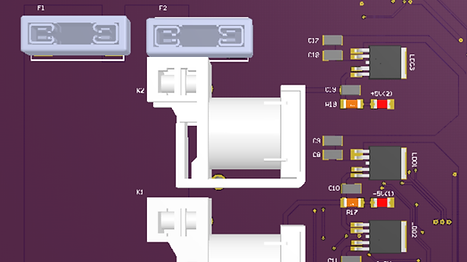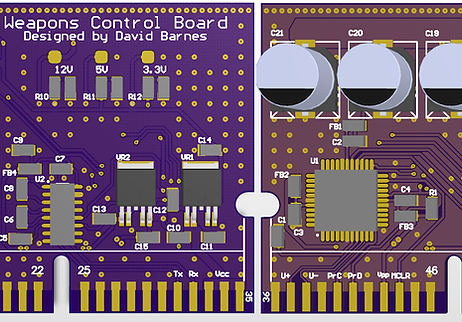Have questions about our application process? Drop us a message.
Have questions about our application process? Drop us a message.
Have questions about our application process? Drop us a message.

SAN DIEGO STATE UNIVERSITY
Mechatronics
DEFIANCE
2015 - 2016
electrical
Defiance's electrical system consists of power distribution, custom built electronics and commercial off-the-shelf electronics. Defiance features eight brushed-DC thrusters, a reliable power system, small electronics form factor, and an organized wire management. There are eight custom manufactured printed circuit boards (PCBs) that were designed, prototyped, assembled, debugged and integrated.


power distribution
The power sources for Defiance are two StarkPower Lithium Iron Phosphate 24V 10AH batteries that range from 21V to 30V with a maximum output current of 15A. A Mini-Box M4-ATX, 250W, 6V to 30V wide input intelligent automotive DC-DC power supply was used to power the main computer.
electronics
The electronics package consists of a passive backplane for use with eight daughter cards that utilize PIC24 microcontrollers for communication and signaling. The modular design allowed the electrical team to divide the electronics design, verification, and testing into manageable modules.


The backplane improved wire management and enabled a modular electronic design. Power and signal traces were routed within the 4 layers of the backplane. Several voltage regulator module PCB-PCB connectors were used to interconnect daughter cards to the backplane. On-shore technology terminal blocks were also used.
backplane & integration
Power Management & Undervoltage detection
The Power Management and Undervoltage Detection (PMUD) board delivers power to the backplane from the two parallel batteries. PMUD monitors and routes battery power to the DC-DC converters, thrusters, and weapons. Additionally, PMUD contains kill switch circuitry to physically disconnect power from thrusters and weapons and not from the DC-DC converters.


Thruster Control Board
The Thruster Control Board (TCB) drives four SeaBotix BTD150 Brushed DC thrusters. As a result, there are two TCBs onboard Defiance to accommodate eight thrusters. During normal operation, each TCB receives power from the 6V plane and delivers unregulated battery power to four H-bridge circuits to drive the thrusters. The TCB monitors current consumption in the each thruster, which is then communicated to the main computer and recorded.
weapons control board
The Weapons Control Board (WCB), controls and supplies power to a HiTEC HS-5646WP waterproof servo. When actuated, the servo controls dropping two ball bearings. In addition, WCB has serial communication with four Dynamixel AX-18A servos that make up the manipulator. To supply power to Dynamixel servos, WCB includes an on board buck converter which steps battery power down.


communication board
The USB to RS-232 communications board (COM), is a custom serial communications hub that fits the modular daughter card form factor. The COM facilitates communication between the main computer and potentially seven daughter cards connected to the backplane. It also features transmit and receive LEDs to aid debugging.
sensor interface board
The Sensor Interface Board (SIB), features triple redundant sensors for measuring internal temperature, internal pressure, internal humidity, external pressure and leaks inside of the vehicle. The SIB also communicates with all of the sensors over inter integrated circuit (I2C) and send the sensor data to the main computer. It also features leak detection functionality.


communication board
The USB to RS-232 communications board (COM), is a custom serial communications hub that fits the modular daughter card form factor. The COM facilitates communication between the main computer and potentially seven daughter cards connected to the backplane. It also features transmit and receive LEDs to aid debugging.

Hydrophones & direction rendering analysis system
The Hydrophones and Direction Rendering Analysis System (HYDRAS) board allows Defiance to locate an underwater pinger, which can be achieved by either using the signal received by Defiance's two horizontally spaced hydrophones or measuring the phase angle between the two real sinusoids received by the hydrophones.
Doppler velocity log communications board
The Doppler Velocity Log Communications board (DVL COM) is a custom serial communications hub that fits the form factor of the DVL. The DVL COM allows communication of the data from the DVL to the main computer, which gives us Defiance's position underwater.
